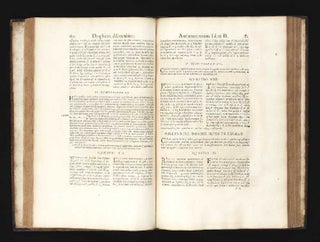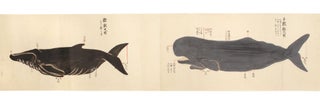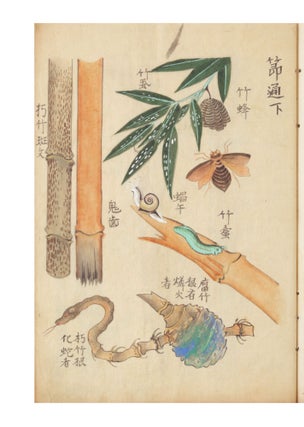“Priceless Records of the Earlier Stages of the Chinese Language”
What Did It Sound Like?
INKYO 韻鏡 [in Chinese: Yunjing; Mirror of Rhymes].
Ten columns per page, 20 characters per column. 52 folding leaves. Large 8vo (280 x 203 mm.), later wrappers, new stitching. [Japan]: colophon dated “1564.”
The earliest surviving edition of one of the “two priceless records of the earlier stages of the Chinese language.”–Edwin G. Pulleyblank, “Qieyun and Yunjing: The Essential Foundation for Chinese Historical Linguistics“ in Journal of the American Oriental Society, Vol. 118, No. 2 (April-June 1998), p. 213. The Yunjing, along with its predecessor, the Qieyun, were the standard pronunciation guides of the Early Middle Chinese and Middle Chinese periods.
This is a very rare book, with only three (or, perhaps, two) other known copies.
The original motivation to compile these guides to pronunciation was religious: Chinese monks turned their attention to the analysis of the sounds of their own language as recitations of chants depended for their effectiveness on correct pronunciation. The need for rhyming tables soon extended to scholarly and practical purposes as well. By the sixth century, educated speech of the south and that of the north had diverged but were still mutually intelligible and sufficiently unified to constitute a common language. The aim of the first such rhyming table, the Qieyun (601), was to codify this common standard, a lingua franca for the elite, preserving a maximum number of distinctions between syllables. The Qieyun went through many revisions and enlargements during the succeeding Tang period. “The earliest extant complete rhyme table is the Yunjing [or, in Japanese: Inkyo] (Mirror of Rhymes), now known only in an edition [by Linzhi Zhang (active 1161-1203)] of the southern Song period (the prefaces are dated 1161, [1197], and 1203), but datable by internal evidence originally to the ninth or tenth century.”–Pulleyblank, “Chinese Traditional Phonology” in Asia Major, Third Series, vol. 12, No. 2 (1999), p. 114 (and much of our description is based on this fine article, which explains how these rhyming tables work).
The Yunjing comprises a series of charts that arrange Chinese characters in large tables according to their tone and syllable structures to indicate their proper pronunciations. It is the essential foundation for Chinese historical linguistics and remains the essential guide to Middle Chinese phonology.
The Yunjing came to Japan in the 13th century in either manuscript or printed book format, where it was preserved (no printed copies or manuscripts survive in China). There was an edition printed in Japan in 1528 of the text, now called in Japanese Inkyo — but no copy survives. The Afterword (see below) in our edition is the only early record of the existence of the 1528 edition.
Our edition, of 1564, which might be considered a Gozan-ban, is the earliest extant edition of the text to survive, in China or Japan. Zhang’s two Prefaces, dated 1197 and 1203, are printed here. The Afterword, dated 1528, was written by the prominent Confucian scholar Nobukata Kiyohara (1475-1550). In his Afterword, Kiyohara furnishes the valuable information that this book was copied in Japan from the Chinese edition and that the 1528 edition was published by Munenaka (or Sochu) Ronshi, a scholarly Buddhist practitioner and friend of Kiyohara, at the Komyoji Temple, in Sakai, south of Osaka. There were many editions of the Inkyo in following centuries, including a movable type edition of 1608.
These 43 tables of guides to pronunciation are remarkable for their complexity and, at the same time, their simplicity. While religious motives were the original reason for the interest in correct pronunciation, other scholarly needs expanded the importance of the Yunjing in China and the Inkyo in Japan. It is considered to be of the greatest importance to Chinese and Japanese scholars from the 12th century to the present day. Facsimiles were made in Japan by Chinese scholars in the early 20th century and brought back to China.
According to the Union Catalogue of Early Japanese books, there are several other copies of the 1564 edition: Kyoto University, Kokubunken (National Institute of Japanese Literature), and, maybe, the Toyo Bunko.
PROVENANCE: stamp of the Mitsui family on first leaf. There are a number of early marginal annotations in black and red.
A very good copy, preserved in a rather handsome chitsu. There is some worming throughout, touching characters and well-repaired. The final leaf is rather heavily repaired but with no loss of text. Minor staining here and there. There was a copy in the Donald and Mary Hyde collection, very under-catalogued (lot 71).
Price: $100,000.00
Item ID: 7040

![Item ID: 7040 INKYO 韻鏡 [in Chinese: Yunjing; Mirror of Rhymes]. INKYO.](https://jonathanahill.cdn.bibliopolis.com/pictures/7040.jpg?width=768&height=1000&fit=bounds&auto=webp&v=1588722861)
![INKYO 韻鏡 [in Chinese: Yunjing; Mirror of Rhymes].](https://jonathanahill.cdn.bibliopolis.com/pictures/7040_2.jpg?width=320&height=427&fit=bounds&auto=webp&v=1588722861)
![INKYO 韻鏡 [in Chinese: Yunjing; Mirror of Rhymes].](https://jonathanahill.cdn.bibliopolis.com/pictures/7040_3.jpg?width=320&height=427&fit=bounds&auto=webp&v=1588722861)
![INKYO 韻鏡 [in Chinese: Yunjing; Mirror of Rhymes].](https://jonathanahill.cdn.bibliopolis.com/pictures/7040_4.jpg?width=320&height=427&fit=bounds&auto=webp&v=1588722861)
![INKYO 韻鏡 [in Chinese: Yunjing; Mirror of Rhymes].](https://jonathanahill.cdn.bibliopolis.com/pictures/7040_5.jpg?width=320&height=427&fit=bounds&auto=webp&v=1588722861)


![Shozaishu 匠材集 [Dictionary of Renga Poetry [or] Collection of Building Materials. Joha 里村紹巴 SATOMURA.](https://jonathanahill.cdn.bibliopolis.com/pictures/6999.jpg?width=320&height=427&fit=bounds&auto=webp&v=1588723281)
